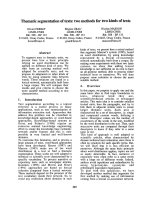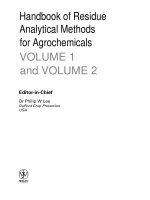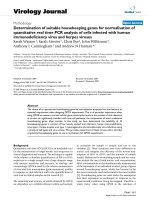Standardization of suitable drying methods for storing groundnut and sesame seeds
Bạn đang xem bản rút gọn của tài liệu. Xem và tải ngay bản đầy đủ của tài liệu tại đây (470.27 KB, 8 trang )
Int.J.Curr.Microbiol.App.Sci (2020) 9(5): 478-485
International Journal of Current Microbiology and Applied Sciences
ISSN: 2319-7706 Volume 9 Number 5 (2020)
Journal homepage:
Original Research Article
/>
Standardization of Suitable Drying Methods for Storing
Groundnut and Sesame Seeds
V. Vijaya Geetha1* and M. Bhaskaran2
1
Oilseeds Research Station, TNAU, Tindivanam, Tamil Nadu, India
2
RRS, TNAU, Tirur, Tamil Nadu, India
*Corresponding author
ABSTRACT
Keywords
Groundnut, sun
drying, shade
drying, storage,
germination
percentage, seed
moisture, field
emergence
Article Info
Accepted:
05 April 2020
Available Online:
10 May 2020
India is one of the important oilseeds grower and importer of edible oils. India stands fourth in oil production
next to USA, China & Brazil. An oilseed crop like groundnut, sesame and sunflower have been the backbone of
several agricultural economies and plays a vital role in agricultural industries and trade throughout the world.
Drying of seeds plays a major role in maintaining the quality of seeds. Drying of Rabi harvested Groundnut as
well as Sesame seeds is a very big challenge as far as Tindivanam is concerned. Since the seeds were exposed to
very hot sun, it leads to cracking of seed coat which in turn leads to poor germination. Hence, to avoid exposing
the groundnut as well as sesame seeds to very high temperature, the seed drying method is to be standardized for
each seeds. To find the suitable seed drying methods for Groundnut TMV 13 and Sesame TMV 7, the seeds of
Groundnut TMV 13 and Sesame TMV 7 were subjected to three methods of drying viz., Sun drying (Completely
under sun), Shade drying (under tree shade)and Partial shade drying (morning under shade and evening under
sun). The pods were dried to the uniform moisture content of 9% and packed in cloth bags and stored under
ambient condition for ten month at Oilseeds Research Station, Tindivanam. The seeds were evaluated for
Moisture content, Germination percentage, Shoot length, Root length, Vigour index, Dry Matter production,
Electrical Conductivity and Field Emergence at monthly interval. Seed storage studies revealed that the decrease
in germination was faster in seeds groundnut seeds. The germination per cent decreased from 95.7 to 49.3 per
cent during 10 months of storage. The vigour parameters like root and shoot length, dry matter production of
seedlings, vigour index values and field emergence per cent decreased with increase in storage period. The seeds
dried under shade registered maximum germination percent (79.4 percent), vigour index (2098), Dry matter
Production (2.89 mg/seedling), Electrical Conductivity 0.312 ds/m and Field emergence (72.5 percent). Similar
trend has been observed for Sesame seeds also. In sesame, Minimum fluctuation in seed moisture content was
observed in sesame seeds under different drying methods. The shade dried sesame seeds with initial moisture
content of 8 per cent, stored in cloth bag recorded the highest germination (83.8 per cent), longest root and shoot
length, maximum dry matter accumulation (34.4 mg), maximum vigour index (1219) and field emergence (80.8
per cent)at end of tenth month of storage.
throughout the world. Sesame (Sesamum
indicum) commonly known as til (Hindi) is an
ancient oilseed crop of India. It is called as
‘queen’ of oilseeds by virtue of its excellent
oil quality (Vijaya Kumar et al., 2014). Seed
is being a biological or living entity,
deterioration in is inevitable and inexorable.
Introduction
Groundnut [Arachis hypogea (L.)] is an
important oilseeds crop and it has vital role in
the diet of rurals and urbans. Groundnut also
known as peanut is considered as one of the
most important oilseed crops and grown
478
Int.J.Curr.Microbiol.App.Sci (2020) 9(5): 478-485
Deterioration occurs with advance in ageing,
during storage, number of biotic and abiotic
factors influences the storage of seeds (Kumar
et al., 2014). Maintenance of quality of seed
during storage is a big menace due its quick
viability loss. The extent of seed deterioration
depends on many factors which includes
species, seed containers, seed treatment,
storage environment, duration of storage
period and initial quality of seeds. Different
chemicals can be used for protection of seeds.
Groundnut being a poor storer, Storing of
groundnut seeds after harvest till the next
cropping season without deteriorating the
quality of seed for successful and quality seed
production. The loss of seed viability is more
severe in groundnut produced during Rabi
season and harvested in the summer season
and about more than fifty per cent viability
could be lost within 4-5 months of storage.
T2 – Shade drying (Completely under shade)
T3– Partial Shade drying (Partially under tree
shade)
Seed storage in groundnut is an imperative,
seasonal demand, dormancy, specificity of
planting time, necessity of carry over and
need of buffer seed stock. Seeds with high oil
content appear to lose their germination and
vigour in a short time despite the precaution
taken during harvesting and drying. High
temperature and high relative humidity cause
severe and rapid deterioration of viability and
vigour of groundnut seeds. The environmental
conditions that exist during the growth period
and harvesting time affects the seed quality
and storability. Thus, the environment /
provenance plays a major role in determining
the seed storability and quality.
Groundnut
After drying, the pods were dried to the
uniform moisture content of 8 % and packed
in cloth bags and stored under ambient
condition for ten month. The seeds were
evaluated at bimonthly interval for first six
months and monthly interval from sixth
months onwards for its quality parameters
viz., Germination Percentage (ISTA,1999),
Root length (cm), Shoot length (cm), Dry
matter production (g 10 seedling -1), Vigour
index (Abdul-Baki and Anderson, 1973),
Electrical Conductivity (dsm-1) (Presley,
1958), Oil Content % (Sadasivam and
Manickam, 1995) and Field Emergence (%).
Results and Discussion
Fluctuation and significant difference in
moisture content was observed due to seed
treatment and Period of storage (Table.1).
Among the various seed treatments, the Seeds
dried under shade registered the minimum
fluctuation in moisture content (8.4 to 8.65
per cent).The decline in germination from 95
per cent to 47 per cent was observed during
storage period (Table. 1). The vigour
parameters like root and shoot length, dry
matter production and vigour index values
(Table. 2) were decreased with advancement
of storage period, irrespective of drying
methods and decrease in these parameters was
rather slow in shade dried seeds. Dry matter
production due to treatments and period of
storage was significant (Table.2). Among the
various drying methods, Shade dried seeds
registered the maximum dry matter (2.89 g)
followed by Partial shade drying (2.71 g). The
electrical conductivity in the seed leachate
increased with increase in storage period from
0.126 to 0.614 dSm-1 (Table.3). Field
Materials and Methods
Freshly harvested seeds of groundnut TMV
13 and Sesame TMV 7 obtained from
Oilseeds Research Station, Tindivanam
formed the base material for the study. The
seeds were subjected to the following
treatments
T1 – Sun drying (Morning and Evening)
479
Int.J.Curr.Microbiol.App.Sci (2020) 9(5): 478-485
emergence potential of the shade dried seed
was maximum (72.2%) compared to Sun
dried (67.8%) and Partial Shade dried (69.9
%) (Table-3).
Sesame
dried seed. This clearly showed that the sun
dried seed might have experienced a slight
injury to membrane due to higher temperature
prevailed during drying. The increase in
electrical conductivity with the advancement
of storage period (Table.6).
In the present study a significant difference
was noticed between drying methods and
period of storage. Here the moisture
fluctuations occurs due to very hot
temperature after six months of storage
(Table.4). Decline in germination is the last
physiological phenomenon in the process of
ageing. In the present study, reduction in
germination was noticed in seeds produced
under rainfed as well as irrigated condition
over a period of storage.
The field emergence potential is considered to
be an important parameter for assessing the
potentiality of seeds to perform better under
field conditions. The present study revealed
that, as the storage period advanced field
emergence potential reduced gradually,
irrespective of seed drying methods. Among
the different drying methods, shade dried
seeds registered maximum seed field
emergence (82.3%) compared to sundried
(79.8 %) (Table-6).
The germination per cent decreased from 88
to 82 per cent in shade dried seed after 10
months of storage and 87 to 78 per cent in sun
seed.
(Table.4).
Vigour
is
usually
characterized by the weight of the seedlings
after a period of growth and it is essentially a
physiological phenomenon influenced by the
reserve metabolites, enzyme activities and
growth regulators. Vigour index value, which
is the totality of germination and seedling
growth has been regarded as a good index to
measure the vigour of seeds.
The moisture content of the seed plays a
prime role in determination of storability of
any seed and it increases with advances in
storage period. The moisture content at which
seeds were stored had a significant effect on
seed longevity has been reported by many
authors (Ellis et al., 1990; Nakamura, 1975;
Zheng, 1994). The decline in germination
during storage may be due to depletion of
food reserves, decline in synthetic activity as
reported by Heydecker (1972) and Roberts
(1972) or may be due to the physiological
ageing process.
Loss of vigour precedes loss of viability. In
the present study, the vigour index value
decreased with increase in storage period
from 1502 to 1076 at the end of 10 months
period and decrease in vigour index value was
faster in sun dried seed compared to shade
dried seeds. (Table.5)Dry matter production
due to drying methods and period of storage
was significant (Table.5).
The superiority of shade dried seeds in
maintaining higher germination (79.4 %)
compared to Sun drying (75.9 per cent) in
storage was due to safe drying method which
protect the seed coat from cracking their by
maintaining its germination percent. Similar
result was obtained by Shakuntala (2009) in
sunflower. Seedling length and dry matter
production of the seedling are the
manifestations of the physiological efficiency
of the germinating seeds which depends on
the seed vigour.
Shade drying method registered the maximum
dry matter (36.73 mg) compared to control
(34.92 mg). The initial electrical conductivity
was higher in shade dried seed than in sun
480
Int.J.Curr.Microbiol.App.Sci (2020) 9(5): 478-485
Table.1 Effect of drying methods on Moisture Content and Germination Percentage in Groundnut TMV 13
Treatment
Sun
drying
Shade
drying
Partial
shade
drying
Mean
CD(0.05)
P0
8.1
P2
8.6
Moisture Content
P4
P6
P7
8.8
8.7
8.4
P8
8.1
P9
8.1
P10 Mean
8.0
8.35
P0
95
P2
92
Germination Percentage
P4
P6
P7
P8
P9
89
85
74
66
59
8.4
8.8
9.1
9.0
8.8
8.4
8.3
8.2
8.63
97
94
91
89
78
70
63
53
79.4
8.3
8.6
8.9
8.7
8.5
8.3
8.2
8.1
8.45
96
93
90
87
76
68
61
48
77.4
8.27 8.67 8.93 8.80 8.57 8.27 8.20 8.10
P
T
PxT
0.041
0.025
0.073
0.084
0.051
0.145
8.48
P10 Mean
47
75.9
96.0 93.0 90.0 87.0 76.0 68.0 61.0 49.3
P
T
PxT
0.499
0.305
0.864
0.999
0.612
1.730
77.5
Table.2 Effect of drying methods on Vigour index and Dry Matter Production (mg 10 seedling-1) in Groundnut TMV 13
Dry Matter Production (mg 10 seedling-1)
Vigour Index
Treatment
P0
P2
P4
P6
P7
P8
P9
P10
Mean
P0
P2
P4
P6
P7
P8
P9
P10
Mean
Sun drying
3306
2972
2537
2193
1769
1379
1109
672
1890
3.31
3.25
3.13
3.00
2.69
2.36
2.18
1.79
2.71
Shade
drying
3434
3093
2757
2412
2020
1589
1273
901
2098
3.42
3.36
3.22
3.10
2.91
2.69
2.35
2.05
2.89
Partial
shade
3379
3032
2691
2349
1832
1476
1183
763
1990
3.36
3.28
3.16
3.06
2.81
2.48
2.25
1.88
2.79
Mean
3373
3032
2661
2317
1872
1480
1187
776
1992
3.36
3.30
3.17
3.05
2.80
2.51
2.26
1.91
2.80
CD(0.05)
P
T
PxT
P
T
PxT
13.790
8.445
23.886
0.018
0.011
0.031
27.582
16.891
47.774
0.037
0.023
0.064
481
Int.J.Curr.Microbiol.App.Sci (2020) 9(5): 478-485
Table.3 Effect of drying methods on Electrical Conductivity (dSm-1) and Field Emergence Percentage in Groundnut TMV 13
Electrical Conductivity (dSm-1)
Field Emergence Percentage
Treatment P0
P2
P4
P6
P7
P8
P9
P10 Mean P0
P2
P4
P6
P7
P8
P9 P10 Mean
0.127 0.159 0.196 0.237 0.303 0.45 0.52 0.635 0.328
95
92
87
80
74
56
40
18
Sun
67.8
drying
0.125 0.153 0.193 0.225 0.294 0.432 0.486 0.587 0.312
96
94
90
84
78
61
48
29
Shade
72.5
drying
0.126 0.155 0.195 0.228 0.298 0.396 0.498 0.62 0.315
95
93
89
81
76
58
42
25
Partial
69.9
shade
Mean
0.126 0.156 0.195 0.230 0.298 0.426 0.501 0.614 0.318 95.3 93.0 88.7 81.7 76.0 58.3 43.3 24.0 70.0
P
T
PxT
P
T
PxT
0.003
0.002
0.007
0.771
0.473
1.335
0.008
0.005
0.014
1.543
0.945
2.672
CD(0.05)
Table.4 Effect of drying methods on Moisture Content and Germination Percentage in Sesame TMV 7
Moisture Content
Treatment
Germination Percentage
P0
P2
P4
P6
P8
P10
Mean
P0
P2
P4
P6
P8
P10
Mean
Sun drying
8.0
8.1
8.3
8.5
8.2
8.1
8.20
87
85
83
82
80
78
82.5
Shade drying
8.1
8.2
8.4
8.6
8.3
8.1
8.28
88
87
85
84
83
82
84.8
Partial shade drying
8.0
8.1
8.2
8.5
8.3
8.2
8.22
87
86
84
83
82
80
83.7
Mean
8.03
8.13
8.30
8.53
8.27
8.13
8.23
87.3
86.0
84.0
83.0
81.7
80.0
83.7
CD(0.05)
P
T
PxT
P
T
PxT
0.027
0.020
0.048
0.542
0.383
0.942
0.058
0.041
0.100
1.090
0.771
1.888
482
Int.J.Curr.Microbiol.App.Sci (2020) 9(5): 478-485
Table.5 Effect of drying methods on Vigour index and Dry matter production (mg 10 seedling-1) and in Sesame TMV 7
Vigour Index
Treatment
Dry matter Production
P0
P2
P4
P6
P8
P10
Mean
P0
P2
P4
P6
P8
P10
Mean
Sun drying
1479
1386
1295
1205
1080
975
1237
38.0
37.1
35.0
34.2
33.5
31.7
34.92
Shade drying
1531
1470
1394
1327
1253
1189
1361
38.8
38.1
37.1
36.7
35.3
34.4
36.73
Partial shade
drying
1496
1436
1336
1245
1156
1064
1289
38.2
37.3
36.1
34.7
33.8
32.2
35.38
Mean
1502
1431
1341
1259
1163
1076
1295
38.33
37.50 36.07 35.20 34.20 32.77
35.68
CD(0.05)
P
T
PxT
P
T
PxT
11.969
8.463
20.731
0.530
0.374
0.920
23.943
16.930
41.470
1.062
0.752
1.840
Table.6 Effect of drying methods on Electrical Conductivity (dSm-1) and Field Emergence Percentage in Sesame TMV 7
Electrical Conductivity (dSm-1)
Treatment
P0
P2
P4
P6
Field Emergence Percentage
P8
P10
Mean
P0
P2
P4
P6
P8
P10
Mean
Sun drying
0.076
0.088 0.107 0.147 0.206 0.260
0.147
84
82
80
79
78
76
79.8
Shade drying
0.078
0.085 0.097 0.141 0.199 0.254
0.142
85
84
83
82
80
80
82.3
Partial shade
drying
Mean
0.077
0.087 0.102 0.144 0.203 0.258
0.145
82
82
81
80
79
78
80.3
0.077
0.086 0.102 0.144 0.203 0.257
0.145
83.7
82.7
81.3
80.3
79.0
78.0
80.8
CD(0.05)
P
T
PxT
P
T
PxT
0.060
0.041
0.105
0.444
0.314
0.770
0.121
0.085
0.209
0.890
0.630
1.542
483
Int.J.Curr.Microbiol.App.Sci (2020) 9(5): 478-485
Fig.1 Shade drying
Fig.2 Partial Shade drying
Fig.3 Seedling evaluation
Fig.4 Field Emergence
This might be due to faster deterioration of
cell membrane and also oxidation of
polyunsaturated fatty acids in the membrane
lipid compounds involving free radicle chain
reaction (Srivastava, 1975).
References
Abdul-Baki, A. and Anderson, J. D.(1973).
Vigour determination in soybean by
multiple criteria. chemicals and
containers on seed quality of marigold
during storage. The Bioscan, 9: 937942. Crop. Sci., 13: 630 -633.
Ellis RH, Hong TD, Roberts EH, Tao KL
(1990). Low moisture content limits to
relations between seed longevity and
moisture. Ann. Bot., 65:493-504.
Heydecker, W. 1972. Vigour. In:Viability of
seeds (ed. E.H. Roberts), Chapman and
Hall, London, pp. 209-252.
ISTA, 1999. International Rules for Seed
Testing. Supplement Rules, Seed Sci. &
Technol., 27: 25-30.
Kumar, T. P.; Asha, A. M.; Maruthi, J.B. and
Vishwanath, K. (2014).Influence of
seed treatment
The field emergence is the ultimate measures
of seed vigour (Tonkan, 1969). In the present
study, field emergence per cent also followed
the same trend as that of germination per cent
in respect of drying methods.
From the above study, it is concluded that the
seeds dried under shade especially the rabi
crop maintains the germination and other
vigour parameters during its storage. The
seeds of groundnut and sesame dried under
shade registered highest vigour and viability
upto 8 months of storage compared to other
treatments under ambient condition.
484
Int.J.Curr.Microbiol.App.Sci (2020) 9(5): 478-485
Nakamura S (1975). The most appropriate
moisture contents of seed for their long
life span. Seed Sci. Tech., 3: 747-759.
Panse, V.G. and Sukhatme, P.V., Statistical
Methods for Agricultural Workers,
Indian
Council
of
Agricultural
Research, New Delhi, pp. 167-174
(1967).
Presley, J.T. 1958. Relationship of protoplast
permeability to cotton seed viability and
predisposition to seedling disease. Pl.
Dis. Reporter, 42(7): 582.
Roberts, E.H. 1972. Loss of viability and
crop yields. In: Viability of Seeds (ed.
E.H. Roberts), Chapman and Hall Ltd.,
London. p.313.
Sadasivam, S. and A. Manickam. 1995.
Proteins and enzymes. In:Biochemical
methods
for agricultural sciences,
Wiley Eastern Ltd., New Delhi, pp. 33143.
Saini, Anurag; Patel, M. B.; Patel, J. B.;
Courmule,
SagarR.and
Mandel,
Deepashree2015. Interaction effect of
seed storage containers and seed
treatments on seed quality in groundnut
(arachis hypogea l.) during storage. An
International e-Journal , (2015) Vol. 4,
Issue 3: 228-234 ISSN 2277-9663.
Shakuntala, N.M. (2009). Influence of
planting ratios, staggered planting and
seed polymer coating on seed yield,
quality and storability in rsfh-130
sunflower
hybrid,
Ph.D
thesis,
University of Agricultural Sciences,
Dharwad.
Srivastava, A.K. 1975. Physiological studies
on soybean seed viability during storage
and its practical applicability. Seed
Res., 4(1): 56-67.
Tonkan, J.H.B. 1969. Seedling evaluation:
The use of soil tests. Proc. Intl. Seed
Test. Assoc., 34: 281-289.
Vijay Kumar, Vivek Sharma and S.C.
Sharma. 2014. Impact of Improved
Technologies
on
Productivity
Enhancement ofSesame (Sesamum
indicum L.) Indian J. Dryland Agric.
Res. & Dev. 2014 29(2) : 41-44.
Zheng GH (1994). Ultra-dry seed storage:
Possible improved strategies and
technology for germplasm conservation.
Chin. Biodiv., 2: 61-65.
How to cite this article:
Vijaya Geetha. V. and Bhaskaran. M. 2020. Standardization of Suitable Drying Methods for
Storing Groundnut and Sesame Seeds. Int.J.Curr.Microbiol.App.Sci. 9(05): 478-485.
doi: />
485









